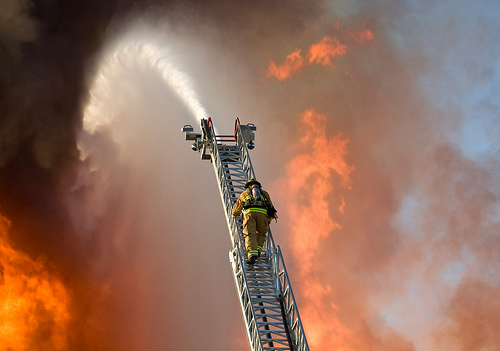The National Fire Protection Association's (NFPA) recent report on forklift fires in the workplace highlights the need for companies to be vigilant in their safety procedures, with figures showing over 20 injuries per year and millions of dollars of damage from fires.
The 'Industrial Loader and Forklift Fires' report says that between 2003 and 2006, US fire departments responded to an estimated average of 1,340 structure and vehicle fires per year where industrial loaders, forklifts and related materials handling vehicles were directly involved.
The report says these fires caused an annual average of 22 injuries and USD36 million in direct property damage.
Almost two-thirds of these incidents were classified as vehicle fires with fires starting in the running gear area or wheel area. An unclassified mechanical failure or malfunction was a factor in 27% of these fires. Electrical failures or malfunctions contributed to 26%. Leaks or breaks were factors in 14%. The other third involved flammable or combustible liquid gas, pipes, or filters as the ignition point. In one-quarter of these incidents, electrical wire or cable insulation was first ignited.
 Fires from forklifts can cause millions of dollars in damage. |
Report author, Marty Ahern, manager, Fire Analysis Services, National Fire Protection Association -Fire Analysis and Research Division, says he decided to write the report because the association receives several questions a year about fires in which forklifts and industrial loaders were involved. "It seemed like it was time to look at the subject in a more systematic manner."
Ahern says forklifts and loaders are unusual vehicles. "Unlike most vehicles used on roads or open areas, these are used in close proximity with large quantities of stored goods," he explains. "Because they move around, they can be a travelling heat source.
"These vehicles or their loads can also damage the structure, its sprinkler system, or its contents. Such damage can result in fire, impaired sprinkler performance, or unintentional sprinkler activations."
Ahern suggests companies obtain a copy of the 2006 edition of 'NFPA 505, Fire Safety Standard for Powered Industrial Trucks Including Type Designations, Areas of Use, Conversions, Maintenance, and Operation' for guidance on safe forklift operation.
"We hope that businesses will use the material in this report to increase their safety," he says. "The statistics typically describe fires where the loader or forklift was the heat source in the fire.
"The incident descriptions show what these statistics can mean in real life. They also show incidents in which a forklift or industrial loader started a string of events that led to a fire.
"This information, combined with that in NFPA 505, can be helpful in developing standard operating procedures and training."
The executive summary and a statistical fact sheet are available at www.nfpa.org. The full report is free to NFPA members. Non-members may purchase the report for $25. To order, contact osds@nfpa.org or (617) 984-7443.